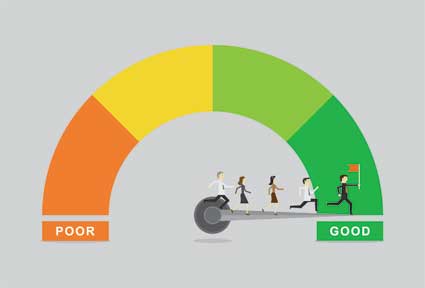Income Statement Overview:
An income statement, also commonly called a profit and loss statement, dictates a business's expenses and revenues over a given, specified period of time. The income statement can also be referred to as the statement of operations or the statement of earnings. The income statement reports on profits(revenues) less the cost of products and company expenses (expenses); it shows revenues, expenses, gains, and losses. The income statement is specific for a given (often times- relatively short) period of time (i.e. a month, quarter or year). The income statement is unique in that it specifically allows investors and managers at the end of the accounting period to understand the results from the operations of the business.
|
Learning Objectives |
|
|
|
|
|
THE MAJOR COMPONENTS OF AN INCOME STATEMENT: |
|
Net Sales, |
|
Costs of Goods Sold |
|
Gross Profit (margin) |
|
Operating Expenses |
|
Taxes |
|
Net Profit After Taxes |
The income statement starts with gross revenues also referred to as sales. After the gross revenues come the amount of money that a company does not expect to collect on sales due to discounts or possible returns. This gives the gross margin. The combination of expenses all adds together to form the operating expenses. The gross margins less the operating expenses give way to the income from operations. The final portion of an income statement includes the income from interest and the negative value of income taxes to yield the net income.
|
WH3 Corp. |
||
|
Income Statement |
||
|
For the Period Ending December 31, 2009 |
||
|
Net Sales |
$156,508 |
|
|
Cost of Sales |
87,846 |
|
|
Gross Margin |
68,662 |
|
|
Operating Expenses |
||
|
R & D Expense |
3,381 |
|
|
Selling, General, and Administrative |
10,040 |
|
|
Total Operating Expenses |
13,421 |
|
|
Operating Income |
55,241 Interested in learning more? Why not take an online Understanding Financial Statements course?
|
|
|
Other Revenue and Expenses |
||
|
Interest and other income, net |
522 |
|
|
Income before taxes |
55,763 |
|
|
Provision for income taxes |
14,030 |
|
|
Net Income |
$41,733 |
|
|
INCOME STATEMENT KEY FORMULAS: |
|
Net sales – Cost of Goods Sold = Gross Margin |
|
Operating Expenses = Sales and Marketing + Research and Development + General and Administrative Expenses |
|
The Gross Margin – operating expenses = Income From Operations |
|
The Income from Operations + The Interest Income – Income taxes = Net Income |
There are two formats of income statements- The Single-Step format and The Multi-Step format:
Single-Step Method:
In the single-step method, the income statement is calculated more simply. The equation used is sales less materials and production equals gross income. From the gross income, marketing and administrative and research and development expenses are subtracted to yield the operating income.
Multi-step Method:
The multi-step method uses multiple variables in the income statements, including net sales, cost of sales, gross profit, selling, general, and administrative expenses, operating income, interest expense, pretax income, income taxes, special items or extraordinary expenses, net income, and comprehensive income. Net sales are the sales or revenue. This is where the income statement begins. Cost of sales is also known as the cost of goods (or products or services) sold. This may include expenses incurred for raw materials, labor and manufacturing overhead used in the production of its goods; it may include the purchase cost of merchandise; and it may include the cost to provide a service or cost of revenues depending on the company type. The gross profit or gross income or gross margin is the difference between the net sales and cost of sales. The value of gross profits provides the means to pay for all other company expenses. The greater gross profits indicate there is a greater chance for an ultimate net income/net profit. Selling, general, and administrative expenses (SG&As) includes a company's operational expensive.
Often times, investors evaluate this value as a percentage of sales to determine the efficiency of management activities and decisions. Operating income is the difference between the SG&A and the gross profit. This value shows the company's earnings prior to deducting non-operating income and costs including interest, expense, taxes, and special items. Interest expense is calculated as the costs of the amount by which a company borrows. The pretax income also helps to give any idea of a company's profitability. This value shows earnings prior to income tax expenses. Income taxes are included in this statement, however they are not actually paid yet, so this is only an estimate and used to just state the amount the company expects to pay. Special items or extraordinary expenses include a variety of "one-time" events, i.e. unusual charges or items that are not expected to recur. These values listed ultimately lead to the net income, also known as net profits or net earnings and the bottom line of the income statement. This value is the value most commonly used to indicate a company's profitability. If a positive value, this becomes a part of company's equity as retained earnings. Comprehensive income is a newer addition to the income statement. This value takes into account outside factors /adjustments like foreign currency, minimum pension liability, and unrealized gains or losses on certain investments in debt and equity.
When considering an income statement, if the net amount of revenue is greater than the expenses and losses, the income statement reflects a net income. If the net amount of revenue is less than the expenses and losses, the income statement reflects a net loss. It is also key to remember that the income statment recognizes only realized revenues. An income statment may not agree with the actual receipt and disbursement of cash. The income statment is a measure of a company's profitiabiltiy, not of a company's cash flow. The net income is added to a company's equity on their balance sheet.
The income statement allows insight into a business's profitability. The income statement shows how much revenue a company earns over a period of time and the associated costs and expenses. The income statement is often used to compare similar periods of time to determine trends based on season and to make predictions of what to expect for a similar, future, time period, this is also known as forecasting future activities. When forecasting, it is important to compare the same time periods due to seasonality. The income statement, outside of predictions/forecasting, allows a company to locate problem areas during a set period of time. There are many reasons for which the income statment is not an accurate or valuable tool. There are many downfalls and disadvantages to using and analyzing an income statment to report trends or estimates. The income statement does not allow insight into the movement of cash. Income satements reprot based on accounting rules and often do not reflect the transfer of cash. Income statements often times are subjective, meaning they may not reliably measure the net profit/loss. It is not possible to measure some critical components, which weigh heavy on profits/losses (i.e. brand loyalty). Some figures depend on accounting methods and can vary depend on the accounting method being used (i.e. first-in-first-out and last-in-first-out accounting. Some values are subjective and therefore depned on judgments and estimates, as opposed to hard numbers/figures. Aside from honest errors, income statments often show intentional misreprensentations.
|
General Income Statement Format |
||
|
Sales |
||
|
? |
Cost of Goods Sold |
|
|
Tax Expense |
Gross Profit |
|
|
applies to income |
? |
Operating Expenses |
|
from continuing |
? |
Nonoperating Expenses (+ Nonoperating Revenues) |
|
operations |
? |
Tax Expense |
|
Income from continuing operations |
||
|
Transitory items |
± |
Discounted Operations, net of tax |
|
are those not |
± |
Extraordinary items, net of tax |
|
expected to recur |
Net Income |
|
Revenues and Revenue Recognition:
Revenues consist of the amount earned through the sale of product (being a good or service). Revenues from primary activities are often times called operating revenues. A primary activity relates to a company's direct form of profit. Revenues from secondary activities are called non-operating revenues. Non-operating revenues occur outside of the direct product/service, which a company deals with. Both revenues and non-operating revenues are reported for the period in which they are earned, not necessarily at the time cash is collected. For example, if products were purchased from a manufacturer on credit, the date of the purchase correlates to the date revenue is received (not the 30days later when actual cash is received). If prepayment for an activity/service is required, revenues occur (and are reported) when the activity/service is initiated, not when the pre-payment is received. Therefore, as you can see, revenues occur when money is earned. There are two fundamental principles that guide the recognition of revenues and expenses as previously stated above. These fundamental principles are known as the revenue recognition principle and the expense recognition (matching) principal.
•Revenue Recognition Principle – The revenue recognition principle states that revenues are recognized when they are earned.
•Expense Recognition (Matching) Principle – The expense recognition principle states that expenses are recognized when they are incurred.
Both the revenue recognition principle and the expense recognition principle are the foundational framework for accrual based accounting which is the system that is used to prepare all Generally Accepted Accounting Principles (GAAP)-based financial statements. There is a general methodology to this approach. The first step is to recognize revenues during the accounting time period which they are earned. Next step is then to record all expenses that were incurred in order to generate those revenues during the same accounting time period. The recording of all expenses that are incurred in order to generate revenues is also referred to as matching the expenses to the revenues. Once this is done net income can then accurately be reported for that accounting period.
It is important to remember that when you are recognizing revenues when they're earned this does not always imply the receipt of cash for payment of cash. The revenue is considered earned when a business has done everything that it is obligated to do meaning that a sale of goods on a credit basis qualifies for revenue recognition so long as the revenues are in fact earned. To further illustrate this point a business will recognize an expense when it is incurred even if there is no cash that has been paid yet. Additionally many businesses recognize the wages, which they pay their employees as expenses even though they will not be paid until the next pay cycle. The business will record an expense yet they pay out no cash; instead what is recorded is an accrued liability for the employee wages payable.
One of the drawbacks to accrual accounting is that it requires estimates and assumptions to be made on behalf of the accountant or business manager. An example of this would include when your business manager tries to estimate how much revenue has been earned from a long-term construction contract, or the amount of accounts receivable that will likely not be collected upon, or even the extent to which equipment and supplies has been exhausted, as well as in the eventual liabilities the business may have to pay for things such as environmental cleanup or various other estimates. All of these estimates have something in common in that they all affect what is reported on both the balance sheet as well as net income.
Expenses:
Expenses consist of the cost of goods sold, selling, general and administrative expenses and interest expense. The cost of goods sold (COGS) is the direct cost as it relates to the production of goods sold by a company. This value includes the cost of materials, direct labor costs for production. It, however, does not include indirect expenses, i.e. expenses that are not directly related to productions costs like distribution costs and sales force costs. The selling, general, and administrative expense (SG&A) is the total value of all direct and indirect selling expenses and all general and administrative expenses to a company. Those direct expenses are those that can be directly linked to the sale of a specific unit i.e. credit, warranty, and advertising expenses. Indirect expenses are those that cannot be directly linked to the sale of a specific unit, but are related to all units sold during the period being evaluated from the income statement like communication charges. General and administrative expenses include expenses as related to the workforce directly related to the sales of products, as well as electric and rent bills associated with this personnel and their work establishment. Finally, research and development are those activities, which a business conducts in order to lead to further development of products and increased sales or new products and procedures. This is a cost that can help lead to future growth for a company. The bottom line of an income statement would yield the new profit/income/earnings or the net losses if an overall debt was incurred.
|
KEY POINTS REVIEW |
|
|
|
|
|
|
|
|



























